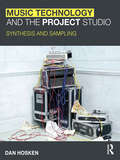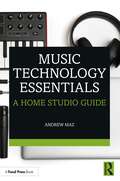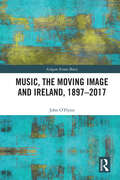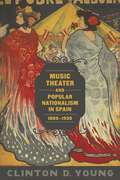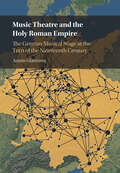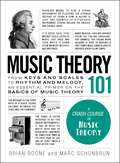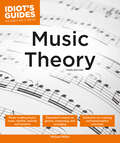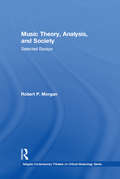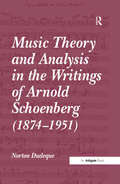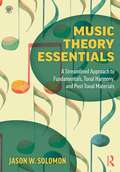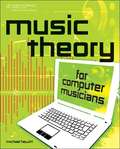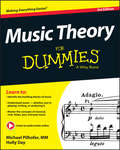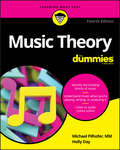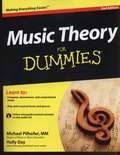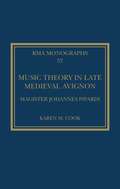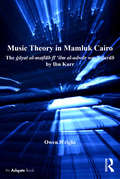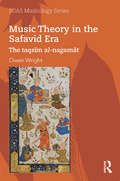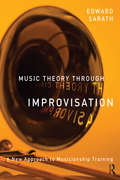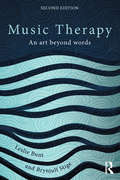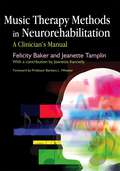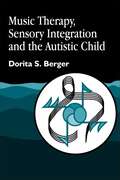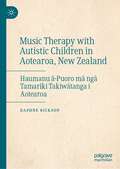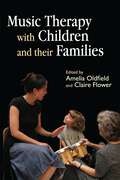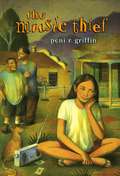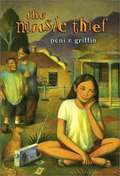- Table View
- List View
Music Technology and the Project Studio: Synthesis and Sampling
by Dan HoskenMusic Technology and the Project Studio: Synthesis and Sampling provides clear explanations of synthesis and sampling techniques and how to use them effectively and creatively. Starting with analog-style synthesis as a basic model, this textbook explores in detail how messages from a MIDI controller or sequencer are used to control elements of a synthesizer to create rich, dynamic sound. Since samplers and sample players are also common in today's software, the book explores the details of sampling and the control of sampled instruments with MIDI messages. This book is not limited to any specific software and is general enough to apply to many different software instruments. Overviews of sound and digital audio provide students with a set of common concepts used throughout the text, and "Technically Speaking" sidebars offer detailed explanations of advanced technical concepts, preparing students for future studies in sound synthesis. Music Technology and the Project Studio: Synthesis and Sampling is an ideal follow-up to the author's An Introduction to Music Technology, although each book can be used independently. The Companion Website includes: Audio examples demonstrating synthesis and sampling techniques Interactive software that allows the reader to experiment with various synthesis techniques Guides relating the material in the book to various software synthesizers and samplers Links to relevant resources, examples, and software
Music Technology Essentials: A Home Studio Guide
by Andrew MazMusic Technology Essentials provides an overview of the vocabulary, techniques, concepts, and devices used in contemporary music production and guides readers through the essential fundamentals of music technology so that they can create their own music productions at home. This highly accessible book covers sound fundamentals and theory, as well as practical topics like hardware, software, MIDI, digital audio, synthesis, computer notation, and audio-visual applications, to equip the reader with the principles they need to achieve professional-sounding results. Each chapter is accompanied by real-life examples and exercises that can be applied to any digital audio workstation software, to put the lessons into practice. This book will also help readers evaluate their requirements for home music production while working within a sensible budget. Music Technology Essentials is the ideal textbook for beginners inside and outside of the classroom, including those on music and music production courses, who wish to enter the world of music technology but are unsure where to start or what to purchase.
Music, the Moving Image and Ireland, 1897–2017 (Ashgate Screen Music Series)
by John O'FlynnMusic, the Moving Image and Ireland, 1897–2017 constitutes the first comprehensive study of music for screen productions from or relating to the island. It identifies and interprets tendencies over the first 120 years of a field comprising the relatively distinct yet often overlapping areas of Irish-themed and Irish-produced film. Dividing into three parts, the book first explores accompaniments and scores for 20th-century Irish-themed narrative features that resulted in significant contributions by many Hollywood, British, continental European and, to a lesser extent, Irish composers, along with the input of many orchestras and other musicians. Its second part is framed by a consideration of various cultural, political and economic developments in both the Republic of Ireland and Northern Ireland from the 1920s (including the Troubles of 1968–1998). Focusing on scoring and other aspects of soundtrack production for domestic newsreel, documentary film and TV programming, it interprets the substantial output of many Irish composers within this milieu, particularly from the 1960s to the 1990s. Also referring to broader cultural and historical themes, the book’s third and final part charts approaches to and developments in music and sound design over various waves of Irish cinema, from its relatively late emergence in the 1970s to an exponential growth and increasingly transnational orientation in the early decades of the 21st century.
Music Theater and Popular Nationalism in Spain, 1880-1930
by Clinton D. YoungFrom its earliest appearance in the mid-1600s, the lyric theater form of zarzuela captivated Spanish audiences with its witty writing and lively musical scores. Clinton D. Young's Music Theater and Popular Nationalism in Spain, 1880-1930 persuasively links zarzuela's celebration of Spanish history and culture to the development of concepts of nationalism and national identity at the dawn of the twentieth century. As a weak Spanish government focused its energy on preventing a recurrence of mid-nineteenth-century political upheavals, the project of articulating a national identity occurred at the popular level, particularly in cultural venues such as the theater. Zarzuela suited this aim well, depicting the lives of everyday citizens amid the rapidly changing norms brought about by industrialization and urbanization. It also integrated regional differences into a unified vision of Spanish national identity: a zarzuela performance set in Madrid could incorporate forms of music and folk dancing native to areas of the country as far distant as Andalucía and Catalonia. A true "music of the people" (música popular), zarzuela offered its audiences an image of what a more modern Spain might look like. Zarzuela alone could not create a unified concept of Spanish identity, particularly with competition from new forms of mass culture and the rise of the Primo de Rivera dictatorship in the 1920s. Yet, as this riveting study shows, it made an indelible contribution to popular culture and nationalism. Young's history brings to life the stories, songs, and evolving contexts of a uniquely Spanish art form.
Music Theatre and the Holy Roman Empire: The German Musical Stage at the Turn of the Nineteenth Century
by Austin GlatthornPacked full of new archival evidence that reveals the interconnected world of music theatre during the 'Classical era', this interdisciplinary study investigates its key locations, genres, music, and musicians. Austin Glatthorn explores the extent to which the Holy Roman Empire delineated, and networked a cultural entity that found expression through music for the German stage. He maps an extensive network of Central European theatres; reconstructs the repertoire they shared; and explores how print media, personal correspondence, and their dissemination shaped and regulated this music. He then investigates the development of German melodrama and examines how articulations of the Holy Roman Empire on the musical stage expressed imperial belonging. Glatthorn engages with the most recent historical interpretations of the Holy Roman Empire and offers quantitative, empirical analysis of repertoire supported by conventional close readings to illustrate a shared culture of music theatre that transcended traditional boundaries in music scholarship.
Music Theory 101: From Keys and Scales to Rhythm and Melody, an Essential Primer on the Basics of Music Theory (Adams 101)
by Brian Boone Marc SchonbrunLearn the basics of music theory in this comprehensive and accessible guide.From classical to hard rock, and jazz to hip hop, music is constantly evolving. But its fundamental principles remain largely unchanged. Understanding these basics is key to becoming a successful musician, composer, or well-rounded music lover. Music Theory 101 covers everything novice musicians and lifelong learners need to know, including:-How to read sheet music-Understanding the construction of chords and scales-The different rhythm and time signatures-How keys are identified and organizedFull of music trivia, music history, comprehensive instruction, and visual aids of scales, music symbols, and chords, Music Theory 101 is the essential guide you need for a crash course in music theory that even professional musicians would envy.
Music Theory, 3E (Idiot's Guides)
by Michael MillerMusic theory doesn&’t need to be complicated, and this guide will show you how to make it simple. Idiot's Guides: Music Theory, Third Edition, is a concise and clear guide that teaches any budding musician or experienced musician how to read musical notation by navigating the basics of reading and composing music. Here&’s what you&’ll find: • The basics of tones, including pitches, clefs, scales, intervals, and major and minor keys • The building blocks of rhythm, including note values, basic notation, time signatures, and tempo, dynamics, and navigation • How tunes are created, starting with melodies, chords, chord progressions, and phrases and forms • The basics of accompaniment, including transcribing, accompanying melodies, and transposing to other keys • Composing and arranging, including coverage of musical genres and forms, how to compose your own music, arranging for voices and instruments, working with lead sheets and scores, and performing your music • Helpful reference appendixes, including a glossary, chord charts, and instrument ranges • Expanded online ear-training and transcribing exercise content, including exercises at the end of each chapter and an answer key appendix
Music Theory, Analysis, and Society: Selected Essays
by RobertP. MorganRobert P. Morgan is one of a small number of music theorists writing in English who treat music theory, and in particular Schenkerian theory, as part of general intellectual life. Morgan‘s writings are renowned within the field of music scholarship: he is the author of the well-known Norton volume Twentieth-Century Music, and of additional books relating to Schenkerian and other theory, analysis and society. This volume of Morgan‘s previously published essays encompasses a broad range of issues, including historical and social issues and is of importance to anyone concerned with modern Western music. His specially written introduction treats his writings as a whole but also provides additional material relating to the articles included in this volume.
Music Theory and Analysis in the Writings of Arnold Schoenberg (1874-1951)
by Norton DudequeArnold Schoenberg's theory of music has been much discussed but his approach to music theory needs a new historical and theoretical assessment in order to provide a clearer understanding of his contributions to music theory and analysis. Norton Dudeque's achievement in this book involves the synthesis of Schoenberg's theoretical ideas from the whole of the composer's working life, including material only published well after his death. The book discusses Schoenberg's rejection of his German music theory heritage and past approaches to music-theory pedagogy, the need for looking at musical structures differently and to avoid aesthetic and stylistic issues. Dudeque provides a unique understanding of the systematization of Schoenberg's tonal-harmonic theory, thematic/motivic-development theory and the links with contemporary and past music theories. The book is complemented by a special section that explores the practical application of the theoretical material already discussed. The focus of this section is on Schoenberg's analytical practice, and the author's response to it. Norton Dudeque therefore provides a comprehensive understanding of Schoenberg's thinking on tonal harmony, motive and form that has hitherto not been attempted.
Music Theory Essentials: A Streamlined Approach to Fundamentals, Tonal Harmony, and Post-Tonal Materials
by Jason W. SolomonMusic Theory Essentials offers an antidote to music theory textbooks that are overly long and dense. Focusing on the essentials, this text provides a clear-cut guide to the key concepts of music theory. Beginning with no assumptions about music theory knowledge, the book covers the core elements of music fundamentals, diatonic and chromatic harmony, post-tonal theory, and popular music in a single concise volume. Emphasizing critical thinking skills, this book guides students through conceptualizing musical concepts and mastering analytic techniques. Each chapter concludes with a selection of applications designed to enhance engagement: Exercises allow students to apply and practice the skills and techniques addressed in the chapter. Brain Teasers challenge students to expand their musical understanding by thinking outside the box. Exploring Music offers strategies for students to apply learned concepts to the music they are currently learning or listening to. Thinking Critically encourages students to think more deeply about music by solving problems and identifying and challenging assumptions. A companion website provides answers to book exercises, additional downloadable exercises, and audio examples. Straightforward and streamlined, Music Theory Essentials is a truly concise yet comprehensive introduction to music theory that is accessible to students of all backgrounds.
Music Theory For Computer Musicians
by Michael HewittMany DJs, gigging musicians, and electronic music producers understand how to play their instruments or make music on the computer, but they lack the basic knowledge of music theory needed to take their music-making to the next level and compose truly professional tracks. Beneath all the enormously different styles of modern electronic music lie certain fundamentals of the musical language that are exactly the same no matter what kind of music you write. It is very important to acquire an understanding of these fundamentals if you are to develop as a musician and music producer. Put simply, you need to know what you are doing with regard to the music that you are writing. Music Theory for Computer Musicians explains these music theory fundamentals in the most simple and accessible way possible. Concepts are taught using the MIDI keyboard environment and today's computer composing and recording software. By reading this book and following the exercises contained within it, you, the aspiring music producer/computer musician, will find yourself making great progress toward understanding and using these fundamentals of the music language. The result will be a great improvement in your ability to write and produce your own original music!
Music Theory For Dummies
by Michael Pilhofer Holly DayGrasp the concepts needed to compose, deconstruct, and comprehend musicWhether you're a student of music or a music lover, Music Theory For Dummies presents you with essential information on how to read, write, and understand music, as well as helpful hints on composing, arranging, and creating original melodies, harmonies, and chords.Music Theory For Dummies gives you a friendly, unintimidating overview of the material covered in a typical college-level course and makes music theory easy to understand. It includes updated information on current teaching techniques; the newest music examples and genres; information on mastering major and minor scales, using intervals, and recognizing pitches and clefs; the lowdown on rhythms, tempo, dynamics, and navigation; how to transcribe the music you hear and transposing it to other keys; harmonizing and accompanying melodies; composing and arranging for voices and instruments; performing your own music; and much more.Audio CD includes musical excerpts played on a variety of instruments Makes learning music theory as enjoyable as it is usefulTracks to a typical college-level music theory courseDon't get discouraged by the seemingly complicated written structure of musical theory. With Music Theory For Dummies, understanding music has never been easier!CD-ROM/DVD and other supplementary materials are not included as part of the e-book file, but are available for download after purchase.
Music Theory For Dummies
by Michael Pilhofer Holly DayTune in to how music really works Whether you’re a student, a performer, or simply a fan, this book makes music theory easy, providing you with a friendly guide to the concepts, artistry, and technical mastery that underlie the production of great music. You’ll quickly become fluent in the fundamentals of knocking out beats, reading scores, and anticipating where a piece should go, giving you a deeper perspective on the works of others — and bringing an extra dimension to your own. Tracking to a typical college-level course, Music Theory For Dummies breaks difficult concepts down to manageable chunks and takes into account every aspect of musical production and appreciation — from the fundamentals of notes and scales to the complexities of expression and instrument tone color. It also examines the latest teaching techniques — all the more important as the study of music, now shown to provide cognitive and learning benefits for both children and adults, becomes more prevalent at all levels. Master major and minor scales, intervals, pitches, and clefs Understand basic notation, time signals, tempo, dynamics, and navigation Employ melodies, chords, progressions, and phrases to form music Compose harmonies and accompanying melodies for voice and instruments Wherever you want to go musically — as a writer or performer, or just as someone who wants to enjoy music to its fullest — this approachable guide gives you everything you need to hear!
Music Theory For Dummies (Second Edition)
by Michael Pilhofer Holly DayGrasp the concepts needed to compose, deconstruct, and comprehend music. Whether you're a student of music or a music lover, "Music Theory For Dummies" presents you with essential information on how to read, write, and understand music, as well as helpful hints on composing, arranging, and creating original melodies, harmonies, and chords. "Music Theory For Dummies" gives you a friendly, unintimidating overview of the material covered in a typical college-level course and makes music theory easy to understand. It includes updated information on current teaching techniques; the newest music examples and genres; information on mastering major and minor scales, using intervals, and recognizing pitches and clefs; the lowdown on rhythms, tempo, dynamics, and navigation; how to transcribe the music you hear and transposing it to other keys; harmonizing and accompanying melodies; composing and arranging for voices and instruments; performing your own music; and much more.
Music Theory in Late Medieval Avignon: Magister Johannes Pipardi (Royal Musical Association Monographs)
by Karen M. CookThe manuscript Seville, Biblioteca Colombina y Capitular 5-2-25, a composite of dozens of theoretical treatises, is one of the primary witnesses to late medieval music theory. Its numerous copies of significant texts have been the focus of substantial scholarly attention to date, but the shorter, unattributed, or fragmentary works have not yet received the same scrutiny. In this monograph, Cook demonstrates that a small group of such works, linked to the otherwise unknown Magister Johannes Pipudi, is in fact much more noteworthy than previous scholarship has observed. The not one but two copies of De arte cantus are in fact one of the earliest known sources for the Libellus cantus mensurabilis, purportedly by Jean des Murs and the most widely copied music theory treatise of its day, while Regulae contrapunctus, Nota quod novem sunt species contrapunctus, and a concluding set of notes in Catalan are early witnesses to the popular Ars contrapuncti treatises also attributed to des Murs. Disclosing newly discovered biographical information, it is revealed that Pipudi is most likely one Johannes Pipardi, familiar to Cardinal Jean de Blauzac, Vicar-General of Avignon. Cook provides the first biographical assessment for him and shows that late fourteenth-century Avignon was a plausible chronological and geographical milieu for the Seville treatises, hinting provocatively at a possible route of transmission for the Libellus from Paris to Italy. The monograph concludes with new transcriptions and the first English translations of the treatises.
Music Theory in Mamluk Cairo: The ġāyat al-maṭlūb fī ‘ilm al-adwār wa-’l-ḍurūb by Ibn Kurr (SOAS Studies in Music)
by Owen WrightThe ġāyat al-maṭlūb fī ‘ilm al-adwār wa-'l-ḍurūb by Ibn Kurr is the only theoretical text of any substance that can be considered representative of musicological discourse in Cairo during the first half of the fourteenth century CE. Indeed, nothing comparable survives from the whole Mamluk period, which extends from 1260 until the Ottoman invasion and conquest of Egypt in 1516. But its value does not derive merely from its fortuitous isolation: it is important, rather, because of the richness of the information it provides with regard to modal and rhythmic structures, and also because of the extent to which the definitions it offers differ from those set forth in an interrelated series of major theoretical works in both Arabic and Persian that span the period from the middle of the thirteenth century to the late fifteenth. Alongside the presumption of transregional uniformity these texts suggest, it consequently asserts the significance of local particularism. Owen Wright provides a critical edition of the text itself, together with a glossary, prefaced by an introduction and a detailed commentary and analysis. The introduction provides immediate context, situating the work in relation to the dominant theoretical tradition of the period and providing biographical information about the author, active in Cairo during the first half of the fourteenth century.
Music Theory in the Safavid Era: The taqsīm al-naġamāt (SOAS Musicology Series)
by Owen WrightThe Safavid era (1501–1722) is one of the most important in the history of Persian culture, celebrated especially for its architecture and art, including miniature paintings that frequently represent singers and instrumentalists. Their presence reflects a sophisticated tradition of music making that was an integral part of court life, yet it is one that remains little known, for the musicological literature of the period is rather thin. <P><P>There is, however, a significant exception: the text presented and analysed here, a hitherto unpublished and anonymous theoretical work probably of the middle of the sixteenth century. With a Sufi background inspiring the use of the nay as a tool of theoretical demonstration, it is exceptional in presenting descriptive accounts of the modes then in use and suggesting how these might be arranged in complex sequences. As it also gives an account of the corpus of rhythmic cycles it provides a unique insight into the basic structures of art-music during the first century of Safavid rule.
Music Theory Through Improvisation: A New Approach to Musicianship Training
by Ed SarathDesigned for Music Theory courses, Music Theory Through Improvisation presents a unique approach to basic theory and musicianship training that examines the study of traditional theory through the art of improvisation. The book follows the same general progression of diatonic to non-diatonic harmony in conventional approaches, but integrates improvisation, composition, keyboard harmony, analysis, and rhythm. Conventional approaches to basic musicianship have largely been oriented toward study of common practice harmony from the Euroclassical tradition, with a heavy emphasis in four-part chorale writing. The author’s entirely new pathway places the study of harmony within improvisation and composition in stylistically diverse format, with jazz and popular music serving as important stylistic sources. Supplemental materials include a play-along audio in the downloadable resources for improvisation and a companion website with resources for students and instructors.
Music Therapy: An art beyond words (Ashgate Popular And Folk Music Ser.)
by Leslie Bunt Brynjulf StigeMusic therapy is recognised as being applicable to a wide range of healthcare and social contexts. Since the first edition of Music Therapy: An art beyond words, it has extended into areas of general medicine, mainstream education and community practice. This new edition revises the historical and theoretical perspectives and recognises the growing evidence and research base in contemporary music therapy. Leslie Bunt and Brynjulf Stige document the historical evolution of music therapy and place the practice within seven current perspectives: medical, behavioural, psychoanalytical, humanistic, transpersonal, culture-centred and music-centred. No single perspective, individual or group approach is privileged, although the focus on the use of sounds and music within therapeutic relationships remains central. Four chapters relate to areas of contemporary practice across different stages of the lifespan: child health, adolescent health, adult health and older adult health. All include case narratives and detailed examples underpinned by selected theoretical and research perspectives. The final two chapters of the book reflect on the evolution of the profession as a community resource and the emergence of music therapy as an academic discipline in its own right. A concise introduction to the current practice of music therapy around the world, Music Therapy: An art beyond words is an invaluable resource for professionals in music therapy and music education, those working in the psychological therapies, social work and other caring professions, and students at all levels.
Music Therapy Methods in Neurorehabilitation: A Clinician's Manual
by Barbara L Wheeler Jeanette Kennelly Felicity Baker Jeanette TamplinThe value of music therapy in neurological rehabilitation is increasingly recognised and this practical manual provides comprehensive guidance for clinicians on the application of music therapy methods in neurorehabilitation. Felicity Baker and Jeanette Tamplin combine research findings with their own clinical experience and present step-by-step instructions and guidelines on how to implement music therapy techniques for a range of therapeutic needs. Photographs clearly illustrate interventions for physical rehabilitation, for example through the use of musical instruments to encourage targeted movement. The chapter on cognitive rehabilitation includes resources and lists suitable songs for use in immediate memory or abstract thinking tasks, among others. In her chapter on paediatric patients, Jeanette Kennelly demonstrates how procedures can be adapted for working clinically with children. A comprehensive list of terminology commonly used in neurological rehabilitation is also included. Music Therapy Methods in Neurorehabilitation will prove an invaluable reference book for music therapy clinicians and students. It is also suitable for work with other populations, in particular for work in special education.
Music Therapy, Sensory Integration and the Autistic Child
by Dorita S. BergerMusic's ability to influence emotions and moods is universally acknowledged, and music therapists have long known that stimulating the brain through the auditory system is a key to obtaining remarkable responses. Music therapy is a particularly effective tool when working with children with autism spectrum conditions, because music communicates with these children on a level where mere words cannot go. Written in a way that is both informative for the professional and accessible for parents, this book furthers the already strong case for the use of music therapy as a resource to encourage behavioural changes for the better in children with autism spectrum conditions. Placing particular emphasis upon sensory integration, the author discusses contributing factors to the behaviour of people on the autism spectrum, and, through the use of case studies, presents the latest approaches in music therapy that are enabling children with autism spectrum conditions to better cope with sensory integration.
Music Therapy with Autistic Children in Aotearoa, New Zealand: Haumanu ā-Puoro mā ngā Tamariki Takiwātanga i Aotearoa
by Daphne RicksonIn this unique text, ten cases of music therapy with autistic children (tamariki takiwātanga) are critiqued through the eyes of family members and other autism experts. Rickson uses her wealth of experience to contextualise their rich observations in a thorough review of research and practice literature, to illustrate the ways music therapists engage autistic children in the music therapy process, highlight the various ways music therapy can support their health and well-being, and demonstrate how music therapy processes align with good practice as outlined in the New Zealand Autism Spectrum Disorder Guideline.
Music Therapy with Children and their Families
by Tiffany Hughes Emma Davies Vince Hesketh Rachel Bull Nicky O'Neill Joy Hasler Kay Sobey Sarah Russel Helen Loth Claire Flower Jassenka Horvat Colette Salkeld Amelia OldfieldIn the past, music therapy work with children typically took place in special schools without the family being present. More recently, music therapy has become a widespread practice, and this book reflects the variety of settings within which music therapists are now working with children together with their families. The contributors are music therapists with experience of working with children and their families in a range of different environments, such as schools, hospices, psychiatric units, child development centres and in the community. They describe their approaches to family work with client groups including children with autism, learning disabled toddlers, adopted children and looked after teenagers. Their experiences demonstrate that involving the family in a child's music therapy can be beneficial for everyone, and that it is possible to address relationship issues within the family as part of the treatment. This book will provide useful insight into the growing area of music therapy with children and their families, and will be valuable for music therapy professionals and students, as well as other medical and teaching professionals who work with families.
The Music Thief
by Peni R. GriffinIn a harsh and noisy time, a young girl's key to her dreams -- music -- may be closer than she thinks.There was a new song playing in the back of Alma's head. An angry song, for Jovita and her killer, and Eddie, and everybody whose family did things that everybody had to live with. She could feel it, thumping in her brain, but couldn't hear it well enough to even hum it. Not in this house.She needed quiet, and a guitar. She needed Mrs. B's house.Alma misses many things. She misses her grandmother; her big brother Eddie back when he didn't deal drugs; the freedom she had before her baby niece Silvita was born; and now, worst of all, she misses Jovita, the singer she idolized who was recently killed in a drive-by shooting. Just when things seem hopeless, Alma discovers the cat door in her neighbor's often-empty home, and an unintended window opens into a better world, full of music.And what could be the harm in Alma's stealing (borrowing, really) a little peace and quiet, maybe even a ticket to her future?Peni R. Griffin has created a character at once bitter and optimistic. She has succeeded, even more impressively, in making the "dark" world surrounding Alma shine with small -- but life-changing -- possibility.
The Music Thief
by Peni R. GriffinAlma misses many things. She misses her grandmother; her big brother Eddie back when he didn't deal drugs; the freedom she had before her baby niece Silvita was born; and now, worst of all, she misses Jovita, the singer she idolized who was recently killed in a drive-by shooting. Just when things seem hopeless, Alma discovers the cat door in her neighbors often-empty home, and an unexpected window opens into a better world, full of music. And what could be the harm in Alma's stealing (borrowing really) a little peace and quiet, maybe even a ticket to her future? Peni R. Griffin has written a stunning novel that is at once brutally honest and realistically hopeful. Alma's world shines with small but life-changing possibility.
